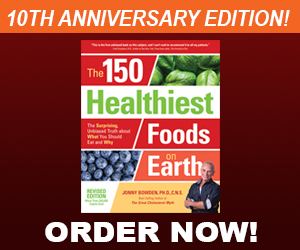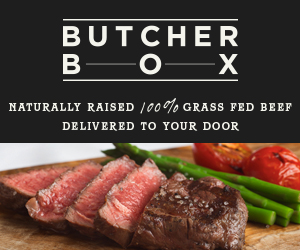With all the talk about how “bad” meat is for you, you might be forgiven for wondering if purchasing organic, grass-fed beef might be a healthier option.
The answer is “yes”.
First, some background. Cows are ruminants, which means that their natural diet is pasture. “You are what you eat” applies equally to animals, and to a cow, pasture- or grass- is the equivalent of “whole foods”. What they’re not supposed to eat is the very food factory farms depend on to fatten them up—grain.
Grain causes their stomachs to become very acid, and also creates meat that is very high in inflammatory omega-6 fats and very low in beneficial anti-inflammatory omega-3’s”.
Cows raised on grain are typically “factory farmed”, meaning they live short brutish lives in confined quarters(1). They get sick- both from living on top of each other and from eating grain, so they’re fed substantial amounts of antibiotics(2) in addition to the growth hormones and steroids they’re given to fatten them up before slaughter. And all this stuff winds up on your plate.(3)
Grass-fed beef, however, is- forgive the pun- a whole different animal. Because grass is so rich in nutrients, the fat of grass-fed beef is richer in anti-inflammatory, heart-healthy omega-3’s(4) and lower in pro-inflammatory omega-6’s. In addition, grass-fed beef contains measurable amounts of CLA, a particularly healthful fat that has been found to reduce tumors in animals by a significant amount(5). Several studies suggest that grass-fed beef has greater levels of vitamin A and E as well as antioxidants like glutathione and superoxide dismutase (SOD) that help fight cancer. (6)
Grass-fed beef is also healthier because of what it does not have.
According to a Time Magazine report, the USDA has determined that grass-fed ground beef is 65% lower in saturated fat, while New York strips are 35% lower. (7) Because the cows are not raised in crowded pens, they get sick far less often and are not routinely fed antibiotics, nor are the “fattened up” on steroids or hormones. The result is beef that is far better for you than ordinary supermarket meat.
“There’s a lot of confusion about the labels “organic” and “grass-fed”, which sometimes overlap”, explains Lowell Novy, DVM. Organic beef simply means the cow was fed organic grain. Organic beef is marginally better because the grain fed to the cows is free of pesticides, but that doesn’t address the bigger problem that beef shouldn’t be raised on a diet of grain in the first place.
All meat labeled “grass-fed” is not necessarily the same. Many grass-fed ranches send their cattle to feedlots for the final weeks of life, where they are fattened up on corn and sometimes given growth hormones as well. “You should look for 100 percent grassfed”, advises Novy, whose Southern California ranch produces only 100% grassfed meat. Up to 2002, the USDA allowed the label “grass-fed” to be used when 80% or more of the animals diet was pasture(8). This regulation was recently updated- USDA certified grass-fed meat is now 100% grass-fed. Without the USDA certified label, however, you can’t be completely sure.
As of 2006, over 1000 US ranchers have switched to an all-grass diet for their cattle. Pasture-raised beef still constitutes only 1% of the nation’s meat supply, but it’s expected to grow at least 20% in the coming decade. (9)
Obviously, raising a 100 % grass-fed animal is far more time consuming and expensive than raising one in a feedlot farm and the price of the meat reflects that. Dry-aging—a process by which the meat is left to “age” for 21 days before being sent to market and one which is not done by every grass-fed ranch—drives the cost up even more (warehousing costs money!) And though the end product is undeniably healthier, many consumers want to know if the taste is worth the extra cost.
The answer is an unequivocal yes. In our “unofficial” taste tests, we cooked up some sample rib-eyes, burgers and T-bones donated by Novy Ranches and served them in a blind taste test to a panel which included two families and one seven-year old.
The verdict was unanimous: each person (except the seven year old) said the beef was otherworldly- succulent, juicy, tender and delicious.
The seven year old simply asked if she could have some more.
You can buy grass-fed meat including beef, lamb, rabbit, pork and bison with confidence from US Wellness Meats, a company I’ve known and liked for years and which is committed to compassionate and humane treatment of their animals as well as to sustainable farming practices
REFERENCES
1) http://www.hsus.org/farm/resources/research/welfare/welfare_overview.html
2) Mellon, M et al. (2001) Hogging It!: Estimates of Antimicrobial Abuse in Livestock, 1st ed. Cambridge, MA: Union of Concerned Scientists.
3) http://www.nytimes.com/2002/03/31/magazine/power-steer.html?pagewanted=1
4) http://www.ncbi.nlm.nih.gov/pubmed/16500874
5) http://www.ncbi.nlm.nih.gov/pubmed/11131667
6) http://www.ncbi.nlm.nih.gov/pubmed/20219103
7) Time Magazine, “The Grass-Fed Revolution” (2006) http://www.time.com/time/magazine/article/0,9171,1200759,00.html
8) “United States Standards for Livestock and Meat Marketing Claims”, Department of Agriculture, Federal Register, Vol 67, No 250; Monday Dec 2002
9) Time Magazine, “The Grass-Fed Revolution” (2006) http://www.time.com/time/magazine/article/0,9171,1200759,00.html








Leave A Comment